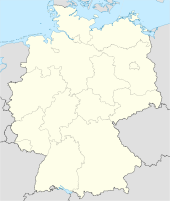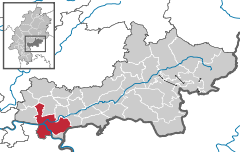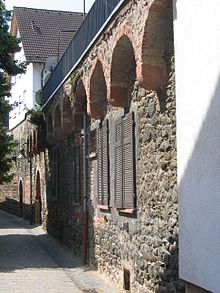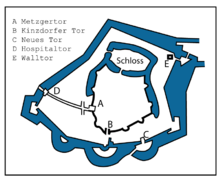- Hanau
-
Hanau 
Coordinates 50°08′0″N 8°55′0″E / 50.133333°N 8.916667°ECoordinates: 50°08′0″N 8°55′0″E / 50.133333°N 8.916667°E Administration Country Germany State Hesse Admin. region Darmstadt District Main-Kinzig-Kreis Lord Mayor Claus Kaminsky (SPD) Basic statistics Area 76.49 km2 (29.53 sq mi) Elevation 104 m (341 ft) Population 88,637 (31 December 2010)[1] - Density 1,159 /km2 (3,001 /sq mi) Other information Time zone CET/CEST (UTC+1/+2) Licence plate HU Postal codes 63450, 63452, 63454 63456, 63457 Area code 06181 Website www.hanau.de Hanau is a town in the Main-Kinzig-Kreis, in Hesse, Germany. It is located 25 km east of Frankfurt am Main. Its station is a major railway junction.
Contents
Geography
The historic core of Hanau is situated within a semicircle of River Kinzig which flows into the River Main just west of it. Today, after a vast expansion during the 19th and 20th centuries it also borders the River Main and after a restructure of municipal borders within Hesse in the 1970s a couple of villages and towns in the neighbourhood were incorporated. This for the first time extended Hanau also to the south bank of River Main.
Districts
- Town center
- Lamboy
- Kesselstadt
- Großauheim
- Klein-Auheim
- Mittelbuchen
- Steinheim
- Wolfgang
- Hohe Tanne
- Wilhelmsbad
Name
The name derived of "Hagenowe" which is a composition out of "Haag" (wood) and "Aue" (open land at the side of a river).
History
The old town of Hanau
As a place of settlement Hanau was first mentioned in 1143. Then it was the site of a castle which used the waters of the River Kinzig as a defense. The castle belonged to a noble family, calling themselves as "of Hanau" since the 13th century. Starting from this castle a village developed and became a town in 1303. Due to this development was the fact, that the main church of this town stood outside its walls in the village of Kinzdorf. The villagers moving into the town, Kinzdorf became an abandoned village leaving only the church. Only in the 15th century the status of the Hanau parish church was transferred to the church of Mary Magdalene within the walls of Hanau.
Shortly after the first town walls were built in the beginning of the 14th century the town outgrow this limit. Outside the wall, along the street heading for Frankfurt am Main a settlement developed (the “Vorstadt”) which was properly included in the fortifications of Hanau only when during the first half of the 16th century Hanau received totally new fortifications in Renaissance-style. These new Fortifications included three elements: The mediaeval castle, the mediaeval town of Hanau and the “Vorstadt”.
The new town of Hanau
At the end of the 16th century, Count Philipp Ludwig II attracted Protestant refugees from the Netherlands and France to found their own settlement south of Hanau. This was of high economic interest for him because these Walloons brought high-class trade, their knowledge of jewellery and other production of luxury items and therefore taxes to his county. Out of this tradition goldsmiths are still educated in Hanau. And in Hanau opened the first workshop to produce Faience within Germany. These new citizens were granted privileges and they formed their own community, church and administration for the “new town of Hanau” (Neustadt Hanau) totally separate from the existing community. It took more than 200 years to amalgamate both. The new town – larger than the old one – was protected by a (then) very modern fortification in Baroque-style which proved a big asset only a few years later in the Thirty Years' War. The town survived a siege in 1637 with only minor damage.
The new citizens formed the mayor economic and political power within the County of Hanau and in 1642 played a leading role in the succession of Count Fredrik Casimir of Hanau Lichtenberg into the county of Hanau-Münzenberg of which the town of Hanau was capital.
In 1736 Johann Reinhard III of Hanau-Lichtenberg, the last of the Counts of Hanau, died. Those parts of his county belonging to the county of Hanau-Münzenberg, which included Hanau, were inherited by the Landgrave of Hesse-Kassel. Due to dynastic troubles within this family the county of Hanau-Münzenberg was created a separate state from the Landgraviate until 1786. So Hanau stayed capital for another 50 years. Even after that it became – after Kassel – the town second in importance within Hesse-Kassel.
19th Century
During the Napoleonic Wars the Emperor himself ordered the fortifications of Hanau to be destroyed. This opened a big chance for the towns to expand over their traditional limits. During the 1820th the administrations of both towns of Hanau were merged. The first common Mayor, who became Lord Mayor (Oberbürgermeister) became Bernhard Eberhard, later the Prime minister and minister of the interior of Kurhessen after the Revolution of 1848.
With its pre-industrial workshops Hanau became a nucleus of a heavy industrialisation during the 19th century: From within the city (e.g.: Heraeus) as well as from outside (e.g. Degussa, Dunlop). This was heavily promoted by its development as an important railway interchange of six railway lines, most of them main lines:
- 1848: Frankfurt-Hanau Railway
- 1854: Main–Spessart Railway
- 1867: Frankfurt–Bebra Railway, eastern direction
- 1873: Frankfurt–Bebra Railway, western direction
- 1879/1881: Friedberg–Hanau Railway
- 1882: Odenwald Railway
In the 19th century, Hanau was a centre of the German democratic movement and contributed significantly both in 1830 and in the Revolution of 1848. As part of this movement the German Gymnastic League (Deutscher Turnerbund) was founded here in 1848.
In the late 19th century Hanau became a major garrison. Due to its interchange of railway lines a large detachment of Military railway-engineers as well as other military units were stationed here.
20th Century
During World War II, Hanau was for the most part destroyed by British airstrikes in March 1945 a few days before it was taken by the US Army. It housed a large US Army garrison until 2008.
In 2010 they started a huge building project to completely redesign the inner city. Those are the biggest workings in the city after the reconstruction of World War II.
At present, many inhabitants work in the technological industry (VAC, Heraeus) or commute to Frankfurt. Frankfurt International Airport is only 30 km away.
Population
- Hanau is the 6th largest town in Hesse. Having recently lost its status as administrative centre of the Main-Kinzig-Kreis (Main-Kinzig district) to Gelnhausen, proposals have been made, that Hanau should form its own administrative district.
- More than 20% of the inhabitants are foreign nationals, mostly Turkish workers.
International relations
Hanau is twinned with 5 other towns[2]:
 Dartford, United Kingdom
Dartford, United Kingdom Tottori, Japan
Tottori, Japan Yaroslavl, Russia
Yaroslavl, Russia Conflans-Sainte-Honorine, France
Conflans-Sainte-Honorine, France Francheville, Rhône, France
Francheville, Rhône, France
(Doorn, Netherlands terminated in January 2009.)
In addition it is associated with two other towns:
 Waltershausen, Thuringia, Germany
Waltershausen, Thuringia, Germany Pays de Hanau, France
Pays de Hanau, France
Sights
- The German House of Goldsmiths (Deutsches Goldschmiedehaus)
- Philippsruhe Castle
- Health Establishment at Hanau-Wilhelmsbad
- St Mary's Church (Marienkirche)
- Walloon-Dutch Church (Wallonisch-Niederländische Kirche)
Famous residents
- The Brothers Grimm (Brüder Grimm) collected many German fairy tales and started work on the German Glossary.
- Ludwig Emil Grimm, painter, younger brother of Jacob and Wilhelm
- Paul Hindemith, composer
- Alois Kottmann, (*1929) violinist, was born in Großauheim
- Rudi Völler, football/soccer world champion 1990 and coach of the German national team, when it was runner-up in 2002.
- Wilhelm Wagenfeld, Designer (1900–1990)
- J. C. C. Devaranne was born in Hanau on March 8, 1784.
- Karl Storck, Romanian sculptor, born in Hanau on March 30, 1887.
- Louis Appia, surgeon, member of the Geneva "Committee of Five" (precursor to the International Committee of the Red Cross)
- Moritz Daniel Oppenheim, painter, often regarded as the first Jewish painter of the modern era.
- Mike Minnix, United States Air Force, Aviation
- Hans Daniel Hassenpflug, German statesman
Sports
- Turngemeinde 1837 Hanau a.V. (TGH), one of the oldest of Germany's sports clubs
- Hanauer Rudergesellschaft 1879 e.V. (HRG), one of Germany's oldest rowing clubs
- 1.Hanauer FC 1893 e.V. (Hanau '93), Hesse's oldest football/soccer club
External links
- Official site (German)
- HanauOnline Webzine (German)
- Staatliche Zeichenakademie Hanau (Hanau State Academy) (German)
Bad Orb | Bad Soden-Salmünster | Biebergemünd | Birstein | Brachttal | Bruchköbel | Erlensee | Flörsbachtal | Freigericht | Gelnhausen | Großkrotzenburg | Gründau | Hammersbach | Hanau | Hasselroth | Jossgrund | Langenselbold | Linsengericht | Maintal | Neuberg | Nidderau | Niederdorfelden | Rodenbach | Ronneburg | Schlüchtern | Schöneck | Sinntal | Steinau an der Straße | WächtersbachReferences
- ^ "Die Bevölkerung der hessischen Gemeinden" (in German). Hessisches Statistisches Landesamt. 31 December 2010. http://www.statistik-hessen.de/static/publikationen/A/AI2_AII_AIII_AV_10-1hj_pdf.zip.
- ^ Twinned towns
Categories:- Towns in Hesse
- Main-Kinzig-Kreis
Wikimedia Foundation. 2010.









